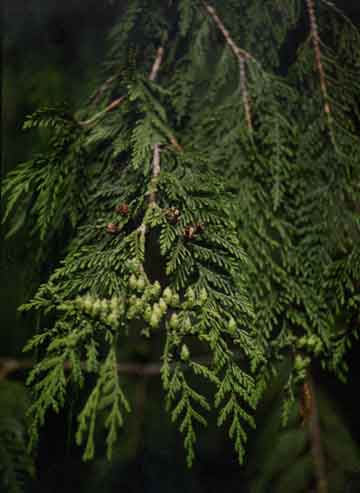
Standard English Name(s):
western red cedar (sometimes spelled redcedar)
Local English Name(s): cedar
Scientific Name(s): Thuja plicata Donn ex D. Don in Lamb.
Upriver Halkomelem Name(s):
Downriver Halkomelem Name(s): xhpey'ulhp![]()
Island Halkomelem Name(s): xhpey'ulhp
(tree) ![]()
Description, Habitat, Ecology, & Distribution:
This is a large, scale-leaved tree, which
reaches a height of 60 m (197 ft). The branches spread or droop, turning
up slightly at the ends. The bark is grey to reddish brown and fibrous
rather than chunky and hard. The seeds are borne in small, egg-shaped
cones. Red cedar usually inhabits moist to wet soils in shaded forests
but it may also occur in drier areas and in bogs. It occurs in low to
high elevations throughout the coast and also in a band east of the
interior plateau of British Columbia.
Upriver Halkomelem Cultural Role(s):
The pliable limbs were twisted into
robe. The shredded bark was used for clothing. The outer bark was used
for splints and canoe-bailers. The inner bark was used for diapers and
tissues. The wood is carved, burned, and used for canoes. The split
roots are used for making baskets. The boughs were used as mats.
Downriver Halkomelem Cultural Role(s):
Island Halkomelem Cultural Role(s):
The inner bark of red cedar may be used
for clothing, hats, ropes, headbands and headdresses. In the past, butter
clams (Saxidomus gigantea) were strung onto strips of red cedar inner
bark to dry over a fire.